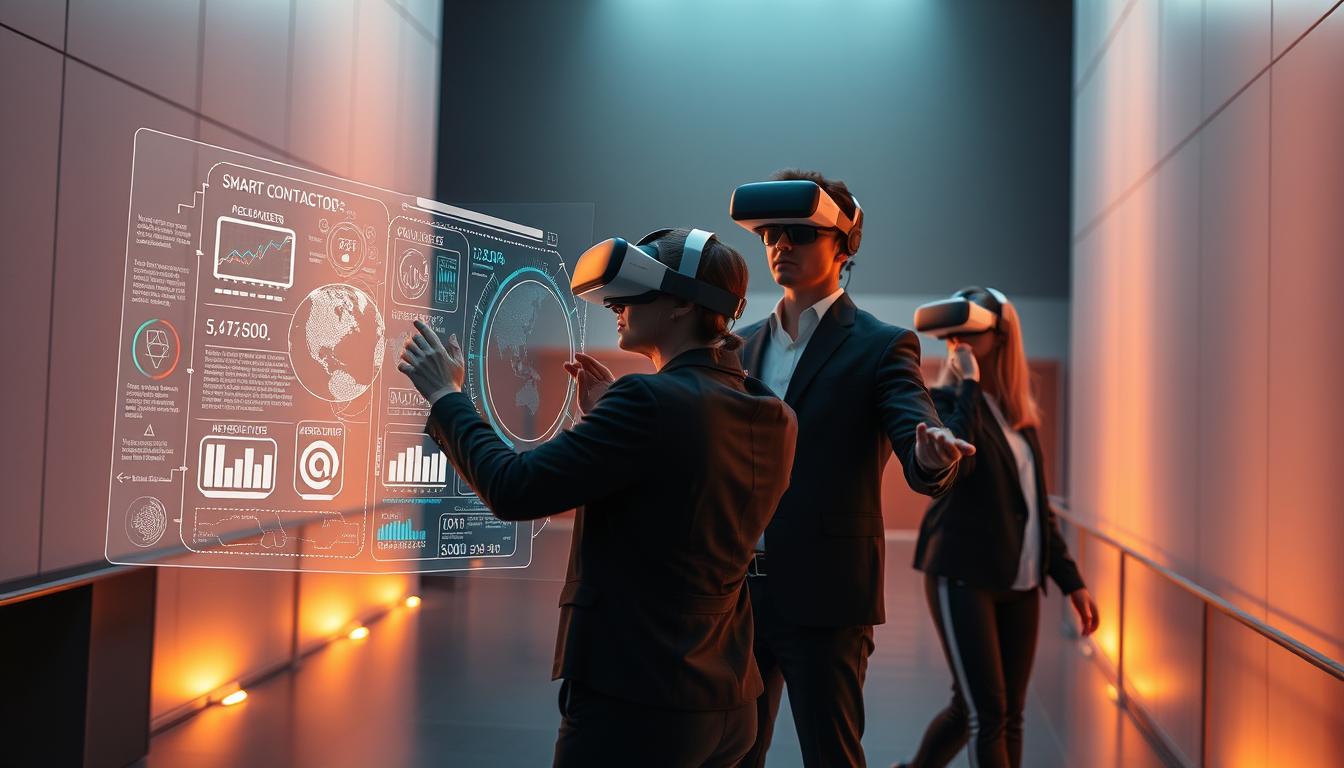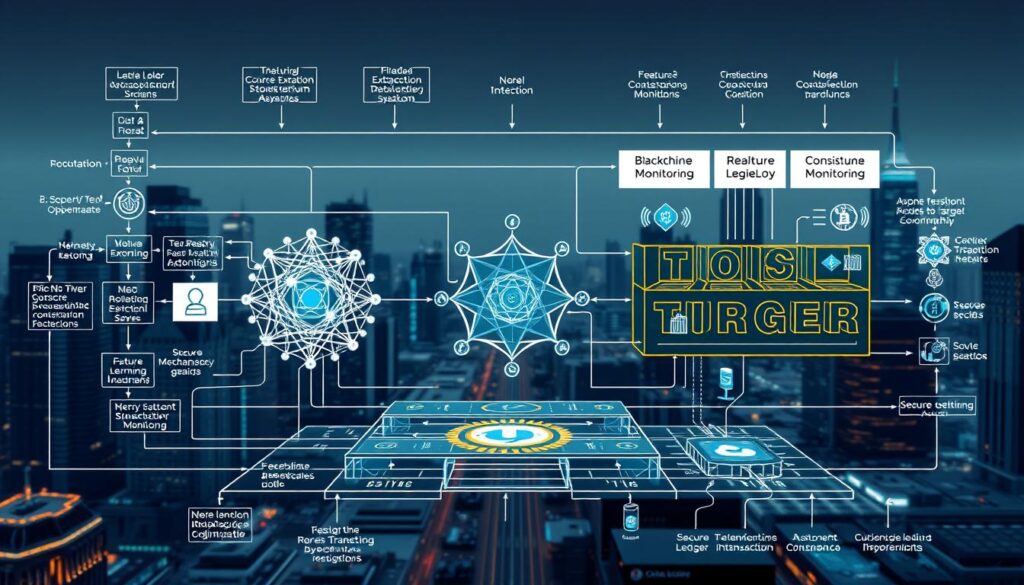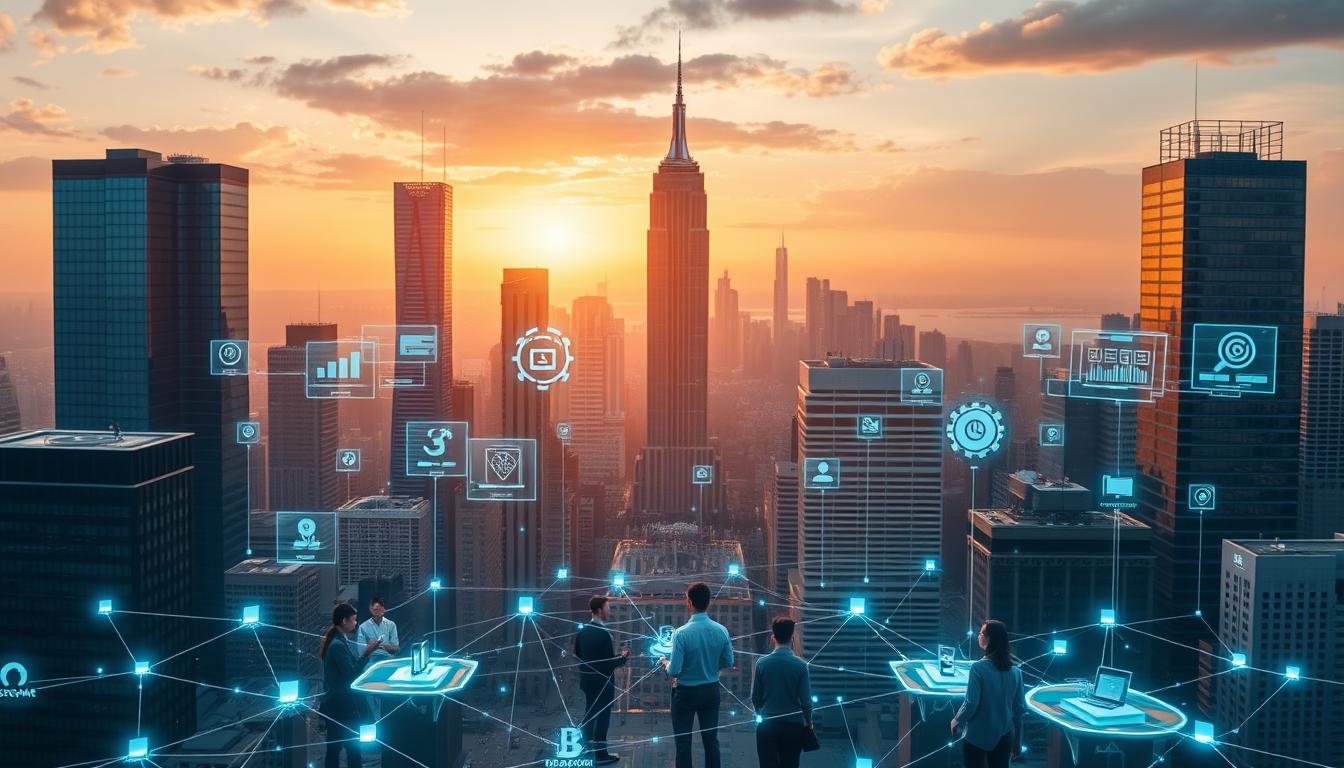Now Reading: AR VR blockchain: Revolutionizing Industries with New Tech
- 01
AR VR blockchain: Revolutionizing Industries with New Tech
AR VR blockchain: Revolutionizing Industries with New Tech

Three powerful forces are reshaping how businesses operate and engage with customers. Spatial computing, artificial intelligence, and decentralized systems are merging to create immersive environments that blend physical and digital worlds. This convergence unlocks new ways to interact with information, assets, and communities.
The numbers tell a compelling story. Recent data shows AR and VR crypto tokens now hold a market value surpassing $4.22 billion. Investor confidence reflects growing belief in these tools to drive web3 innovation. User adoption also surges, with projections suggesting nearly 100 million people explored VR experiences last year.
What makes this shift groundbreaking? Traditional screens are giving way to dynamic 3D interfaces. These systems enable real-time collaboration, secure transactions, and personalized digital ecosystems. Decentralized networks ensure transparency while protecting user ownership—critical for building trust in virtual spaces.
From retail to healthcare, industries are embracing this tech fusion to solve complex challenges. The integration creates opportunities for brands to deliver memorable experiences while streamlining operations. As adoption accelerates, understanding these tools becomes essential for staying competitive.
Key Takeaways
- Converging technologies create immersive digital-physical hybrid environments
- AR/VR crypto token market exceeds $4.22 billion as of early 2024
- VR attracted 98 million users in 2023, with AR adding 23 million more
- Spatial computing enables interactive 3D experiences beyond flat screens
- Decentralized networks provide security for digital transactions and ownership
Understanding the Convergence of AR, VR, and Blockchain
A tech trio is revolutionizing how we interact with digital environments. Spatial computing bridges physical and virtual worlds through advanced tools that respond to human movement. This integration creates dynamic spaces where information becomes tangible and collaborative.

Core Components of Modern Digital Experiences
Augmented reality layers data onto real-world views through devices like smartphones. Imagine seeing navigation arrows on city streets or virtual furniture in your living room. These overlays enhance decision-making without disconnecting users from their surroundings.
Virtual reality transports people into fully designed environments. Special headsets track motion to create convincing simulations for training or entertainment. Users gain immersive experiences that feel nearly real, from exploring distant planets to practicing surgical procedures.
Redefining Engagement Through Spatial Systems
Spatial computing combines these technologies with decentralized networks. Blockchain solutions verify ownership of virtual items, enabling secure trades in leading crypto projects. This framework supports 3D interactions beyond flat screens, letting users manipulate holograms or join shared virtual workspaces.
These systems transform passive scrolling into active exploration. Instead of watching videos, people enter digital realms where they shape outcomes. As spatial tools evolve, they’ll redefine education, commerce, and social connections through embodied online experiences.
AR VR blockchain: Enhancing Immersive Technologies and Market Impact
Digital advancements are creating new industry standards across sectors. From property markets to interactive retail, spatial tools enable users to engage with environments in unprecedented ways. These innovations blend physical and digital interactions while prioritizing user trust through secure frameworks.
Transformative Use Cases in Real Estate, Gaming, and Retail
Property management now offers 3D walkthroughs, letting buyers explore homes remotely. Transactions occur through tamper-proof ledgers, reducing paperwork delays. Gaming platforms empower players with ownership of unique digital items traded across ecosystems.

Retailers leverage augmented interfaces to let customers “try” products at home. One fashion brand saw a 34% sales boost after implementing virtual fitting rooms. Leading platforms driving these changes include:
- Decentraland’s virtual land marketplace
- CEEK VR’s immersive concert venues
- Highstreet’s hybrid shopping-game environments
Improving Security and Data Integrity Through Decentralization
Distributed networks eliminate centralized vulnerabilities in transactions. Every action gets recorded across multiple nodes, making unauthorized changes nearly impossible. Financial institutions now detect fraud 40% faster by combining AI analysis with encrypted ledgers.
This approach ensures product authenticity in retail supply chains. Luxury brands use it to verify item origins, reducing counterfeit risks. As systems evolve, they create safer digital spaces while maintaining user control over assets.
Innovations and Future Trends in Immersive Technology
Emerging technologies are breaking barriers between digital and physical interactions. Cutting-edge tools now respond to human behavior while delivering multi-sensory experiences. These recent developments promise to reshape how we work, learn, and connect in virtual spaces.
Integrating Generative AI with Immersive Applications
Artificial intelligence completes the creative loop in dynamic environments. Systems analyze user preferences to generate custom 3D worlds instantly. A travel app prototype creates personalized virtual tours that adapt to real-time feedback, demonstrating this technology’s potential.
Key advancements include:
- Auto-generated landscapes matching historical or fantasy themes
- Smart characters reacting to voice commands and gestures
- Real-time language translation for global collaboration
Advancements in Sensory Engagement Tools
Spatial audio now places sounds precisely around users’ heads. Imagine hearing raindrops hit your left shoulder in a meditation simulation. Combined with haptic gloves, this technology lets users feel textures like rough stone or flowing water.
Five critical innovations driving future experiences:
- Eye-tracking headsets enabling hands-free navigation
- Full-body suits transmitting temperature changes
- 5G networks supporting instant cloud rendering
- Modular controllers adapting to different virtual tools
- Biometric sensors adjusting environments to stress levels
These tools work together to create immersive ecosystems where digital interactions feel tangible. As computing power grows, expect more intuitive devices that blend seamlessly into daily life while expanding creative possibilities.
Exploring Industry Applications and User Experience Enhancements
Innovative platforms are unlocking new dimensions in how we interact with digital spaces. These tools merge rich visuals with practical utility, transforming how industries operate and how people engage with content.

Virtual Tours, Event Experiences, and Digital Asset Ownership
Real estate and education sectors now leverage immersive virtual tours. Users explore properties or historical sites through detailed 3D environments, enhancing decision-making without physical visits. Tourism platforms offer interactive previews of destinations, boosting booking confidence.
Event platforms like CEEK VR redefine live entertainment. Attendees join global concerts or conferences through 360° video streams. This approach expands audience reach while creating fresh revenue models for creators.
Ownership models evolve through projects like Victoria VR. Users earn rewards by contributing to photorealistic metaverses built on gaming engines. Such systems let participants monetize creations while maintaining control over their digital assets.
Location-based tools take augmented interactions mainstream. OVER’s technology maps physical spaces via smartphones, allowing users to overlay art or information on real-world landmarks. This blend of digital content and environments sparks new commerce opportunities.
Social worlds like NetVRk empower creators with building tools. Communities design unique experiences while earning from secure virtual ecosystems. These platforms demonstrate how user-generated content drives value in modern digital economies.
Key Challenges and Risk Management in the AR/VR Blockchain Ecosystem
Navigating emerging tech landscapes presents unique hurdles for businesses and users. Rapid innovation often outpaces established safeguards, creating vulnerabilities that demand proactive solutions. Companies must balance opportunity assessment with protective measures to sustain growth.
Addressing Security Concerns and Regulatory Uncertainties
Immersive technologies collect sensitive user data like movement patterns and biometric details. This information becomes targets for cyberattacks if storage systems lack encryption. Recent developments show a 67% increase in virtual identity theft attempts since 2022.
Governments struggle to craft regulations for decentralized virtual economies. Conflicting international laws complicate compliance for global platforms. Businesses face fines when local data policies clash with cross-border operations.
Mitigating Market Volatility and Technological Maturity Issues
Crypto projects tied to spatial computing experience 40% wider price swings than traditional assets. Early-stage tools frequently encounter compatibility issues, delaying product launches. One metaverse platform postponed its release twice due to engine upgrades.
Effective risk management combines strategic planning and adaptive frameworks. Key approaches include:
- Third-party audits for smart contract security
- Diversified investment across multiple platforms
- Real-time monitoring of regulatory changes
Proactive measures help businesses harness potential while minimizing exposure. Balancing innovation with caution remains critical in this dynamic sector.
Final Thoughts on the Future of Integrated AR/VR and Blockchain Solutions
The fusion of spatial systems and decentralized networks opens doors to unprecedented digital interaction. This convergence reshapes how we perceive value creation, blending tangible environments with persistent virtual ecosystems. Advancements in wearable devices and processing power will dissolve current hardware limitations, making immersive experiences as common as smartphone use.
Education and healthcare sectors stand to gain immensely. Virtual classrooms could democratize global learning access, while medical simulations enable risk-free surgical training. Real estate markets already show how 3D walkthroughs enhance decision-making – future iterations might integrate live financial transactions within these environments.
Secure transaction protocols will underpin this evolution. Smart contracts automate agreements across virtual marketplaces, while cloud computing handles complex data integration. These frameworks empower users to truly own digital assets, from virtual land parcels to AI-generated content.
As spatial technologies mature, they’ll redefine daily routines. Imagine collaborating with holographic colleagues or attending concerts where the crowd spans continents. The challenge lies in balancing innovation with ethical design – ensuring these tools enrich lives without compromising privacy.
The next decade will test our ability to adapt physical infrastructure to support hybrid worlds. Businesses that master this blend of digital creativity and real-world practicality will lead their industries. Success requires understanding both technological potential and human needs.
FAQ
How do augmented reality and blockchain work together?
Augmented reality overlays digital content onto the physical world, while blockchain secures data ownership and transactions. Together, they enable verified digital asset interactions, like authenticating virtual objects in real-world spaces.
What industries benefit most from spatial computing?
Real estate uses virtual property tours, retail offers immersive shopping, and gaming integrates interactive worlds. Healthcare and education also leverage spatial tools for training and simulations, enhancing user engagement.
Can decentralized systems improve immersive tech security?
Yes. Blockchain’s tamper-proof ledgers protect user data in virtual environments. Smart contracts automate permissions, reducing fraud risks in digital content exchanges or event ticketing.
How does generative AI enhance virtual experiences?
Tools like MidJourney or DALL-E create dynamic 3D assets for virtual worlds. AI-driven avatars also personalize interactions, making simulations more responsive and realistic for users.
What risks exist in adopting these combined technologies?
Regulatory gaps, data privacy concerns, and hardware costs pose challenges. Market volatility in crypto-based ecosystems and interoperability issues between platforms also require careful risk management.
Why is haptic feedback critical for immersive environments?
Devices like Meta’s Touch controllers simulate physical sensations, deepening realism. Combined with spatial audio, haptics create multisensory experiences, crucial for training simulations or virtual events.
How do virtual tours transform real estate marketing?
Platforms like Matterport let buyers explore properties remotely. Blockchain verifies listing authenticity, while AR apps overlay renovation ideas, streamlining decision-making and boosting client trust.
















